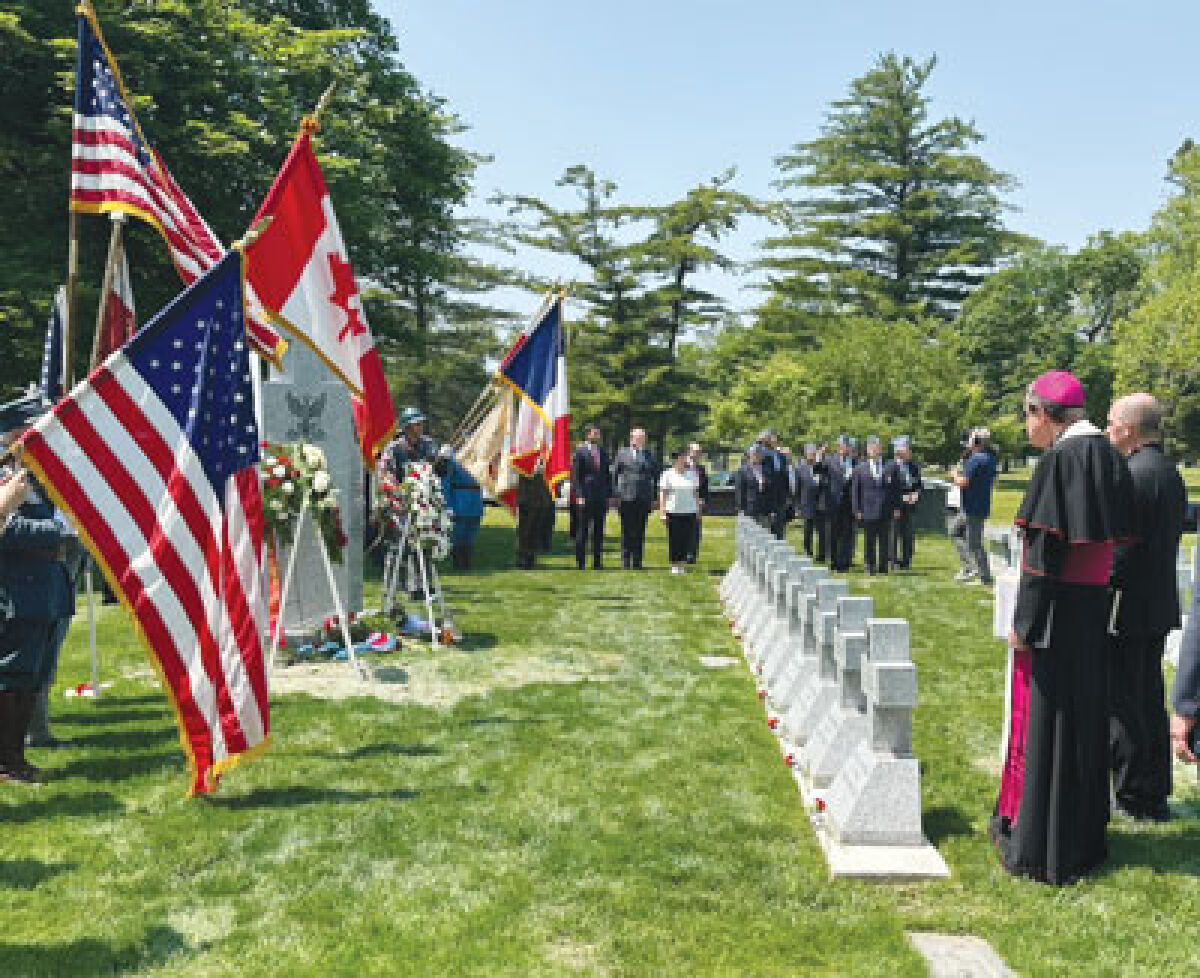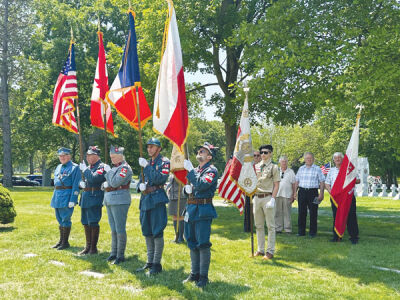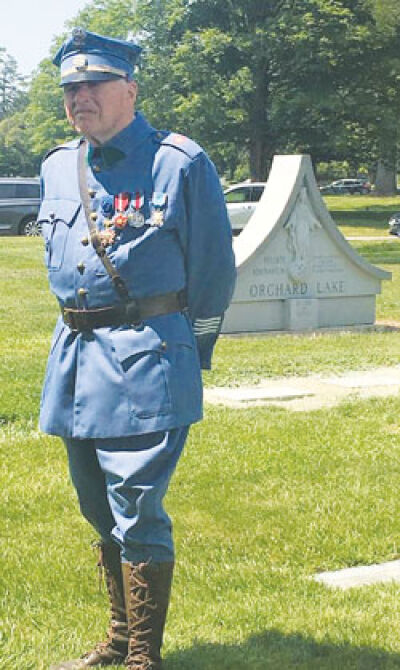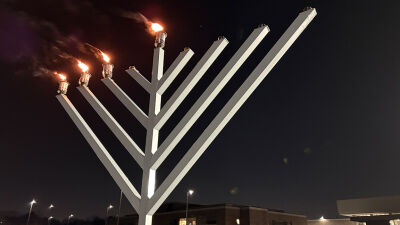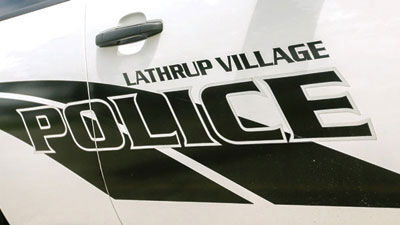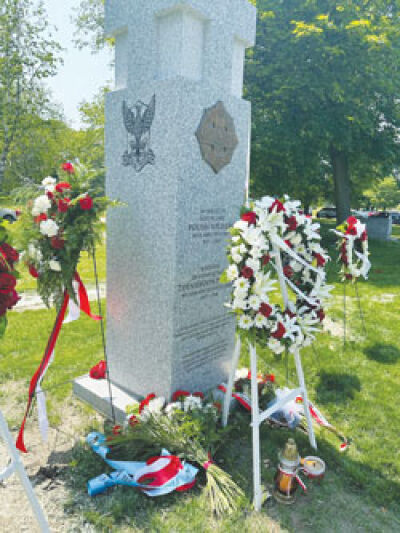
In addition to the dedication of 60 tombstones, a Blue Army monument was also dedicated by Poland’s Institute of National Remembrance.
Photo by the Polish Consulate in Chicago
SOUTHFIELD — Polish Americans gathered in Section No. 5 of Holy Sepulchre Cemetery in Southfield to honor the “Forgotten Volunteers of the Blue Army” with a monument and tombstone dedication recently.
Andrew Gołębiowski, the host of a Polish American radio program in Buffalo, addressed the audience at the memorial.
“For men who have served in the Blue Army as well as other Polish and Polish American veterans, over time, they said we became forgotten,” Gołębiowski said. “And more than half of the graves were unmarked. We are here almost 100 years later because one person, the daughter of a Blue Army veteran, would not allow the men buried here to continue to be invisible to the world. Even though her own father is not buried here, she took it upon herself to make the presence and sacrifice of his comrades known inside and outside of these gates.”
Fifteen years ago, Henrietta Nowakowski, the daughter of a Blue Army soldier, Sgt. 1st Class Ignacy Zapytowski, visited the same gravesite that she remembered visiting with her parents as a child. She became grief-stricken that these brave Polish American men were laid to rest without tombstones.
“It was sad because if you were looking for someone in particular, you’d have no idea where to find him. It seemed like a shame that these men were just totally forgotten with not even a nameplate to say who they are,” she said.
The nameless graves house the bodies of men who served in the Polish Army, or the Blue Army, in France, fighting for Poland’s independence from 1918-1919. From late 1917 to early 1919, over 38,000 volunteers registered in the U.S., with around 22,000 volunteers qualifying for military service. Nowakowski estimates that around 2,000 of these volunteers came from Michigan. After being sworn in, the soldiers were sent to the Kościuszko training camp in Niagara-on-the-Lake, Canada.
On Sept. 28, 1918, the Blue Army was recognized by the Entente powers as independent allies of the Polish Army. The Paris-based Polish National Committee gained the right to appoint a supreme commander of the Polish Army, and Gen. Józef Haller was appointed.
When World War I ended in November of 1918, Poland was still fighting for their independence. The Greater Poland Uprising and Silesian Uprisings broke out, and not much later, the Polish-Bolshevik War began. In 1919, under Haller’s command, the Blue Army was sent to Poland to defend its independence against the Bolshevik Red Army and communism.
By September of 1919, ordered by Marshal Józef Piłsudski, all immigrant armed forces were integrated into the Polish Army, thus removing Haller as the commander of the Blue Army and disbanding the Blue Army. Volunteers from the U.S. were demobilized, which left Polish Americans and soldiers outraged. Though the matter was taken to the United States House of Representatives in 1920, the outcome was that these soldiers would instead be tasked with transporting American cargo to supply American troops stationed in Rhineland.
The soldiers of the Blue Army were recognized with the “Cross of Polish Soldiers from America” and left without resources. At this time, many of the soldiers were disabled or ill.
In 1921, the Polish Army Veterans Association in America was formed, and in 1925, it partnered with the Ladies Auxiliaries to provide aid and care to homeless, unemployed veterans in need. The Ladies Auxiliary No. 5 purchased 72 gravesites for Polish World War I veterans in Holy Sepulchre Cemetery in 1929. However, the families of the veterans were unable to afford tombstones, leaving the graves unmarked and the men laid to rest there unnamed.
Raised by Polish immigrants proud of their Polish heritage and citizenship in the United States, Nowakowski recalled her mother and father, who were involved in veteran groups to help Polish soldiers from World War I and II. For Nowakowski, there was no question about what she had to do.
The seed was planted in 2007 when Nowakowski returned to the gravesite and was disheartened by the lack of grave markers, but it wasn’t until 2017 that her project gained support from the Polish Mission at Orchard Lake and The Institute of National Remembrance in Warsaw.
Nowakowski explained that the project consisted of intense research. It was her mission to make sure that every veteran got his name and history restored. Nowakowski worked endlessly researching. She utilized records that her mother, the secretary of the Ladies Auxiliary No. 5, kept, as well as using archival resources and assistance through the Polish Museum in Chicago, SWAP archives in New York, the Institute of National Remembrance in Warsaw, the Archdiocese of Detroit and the Polish Genealogical Society of Michigan. After years of Nowakowski’s hard work and persistence, her mission was complete. Sixty tombstones and a monument were dedicated by Poland’s Institute of National Remembrance.
“There are 59 occupied graves, and one tombstone is dedicated to the empty grave,” Nowakowski explained. “Fifty-two graves are actually veterans of World War I’s Polish Army; they’re called ‘Hallerczycy,’ because General Józef Haller was their general. So there were 52 of those, there are five Polish Army veterans from World War II. There are two veterans who served in the U.S. forces, one in World War I in the U.S. Navy. According to his biography, he joined because he was in that age bracket, so he was not eligible for the Polish Army. And the other one is a World War II veteran of the United States Army, so there are two that were not in the Polish Army.”
The weekend-long dedication kicked off on Friday, June 16, at 6:30 p.m. at Orchard Lake Schools with a showing of the film “The Voice of the Graves” and a lecture by Jan Lorys on the history of the Blue Army. The official dedication ceremony was held on Saturday, June 17, at Holy Sepulchre Cemetery. The dedication ceremony consisted of a blessing of the monument and tombstones by Archbishop of Detroit Allen Vigneron and Father Bernard Witek (in Polish), a wreath laying at the Blue Army Monument, a reading of the names by Rocky Raczkowski, the playing of taps, a rotary wing honor flyover by the U.S. Coast Guard Air Station Detroit and the Macomb County Sheriff Aviation Unit, and more. The dedication ceremony was followed by a dinner reception held at 5:30 p.m. at the American Polish Cultural Center in Troy. The tribute concluded on Sunday, June 18, with a 10 a.m. Mass at Sweetest Heart of Mary Church in Detroit, followed by a tour of St. Josephat Church.
Nowakowski expressed her relief that the project has come to a close.
“Well, I’m so glad it’s over,” Nowakowski said. “And for me, it’s like now I can die, because I did something worthwhile. And I don’t even have to mention my name. I don’t need any accolades, nothing. Just seeing that is satisfaction enough. I’m so glad this happened. And these men really deserve it.”
 Publication select ▼
Publication select ▼